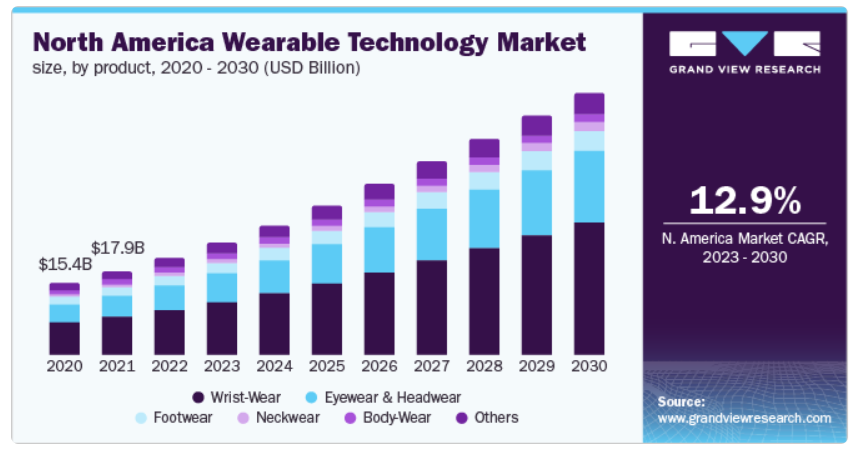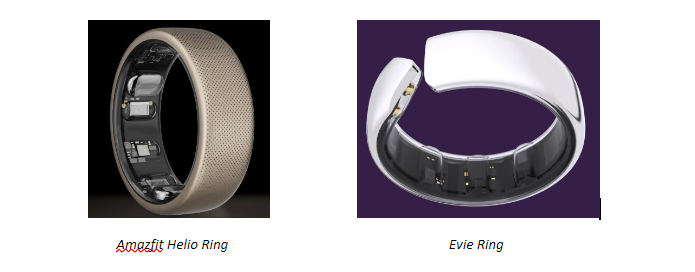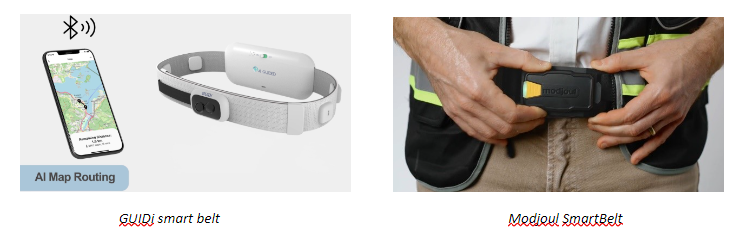The rise of innovation in wearable technology – beyond Smart Watches

The market for wearables continues to grow on a rapid rate. Grand View Research valued the global wearable technology market at USD 61.30 billion in 2022 and forecasted the market to expand at a compound annual growth rate (CAGR) of 14.6% from 2023 to 2030, with the North American market predicted to grow at 12.9% CAGR from 2023 to 2030. Mintel’s UK Smartwatches and Wearable Technology Market Report 2023 estimated the UK’s wearable technology market size at £1,219 million. According to McKinsey’s latest Future of Wellness research where more than 5,000 consumers across China, the United Kingdom, and the United States were surveyed, one-third of the surveyed wearable users said they use their devices more often in 2023 than they did the year before while 75% of those surveyed indicated an openness to using a wearable in the future.

What are wearables?
Wearable technology, commonly known as “wearables” are electronic devices designed to be worn on an individual’s body and can be used for a variety of purposes ranging from training and education to tracking one’s health, wellness and fitness in real-time. Although wristwear products (i.e. smart watches or bracelets) tend to be the more commonly form of wearables adopted by consumers, there are other types of wearables available in the market such as glasses, headbands, clothing, belts, rings, footwear, etc.

Below are a couple of examples of the different forms of wearables, beyond smart watches / bracelets available in the market currently or recently introduced at the 2024 Consumer Electronics Show (CES), with some of these targeting specific demographics such as women, blue-collar workers, athletes, elderly, visually impaired, etc.:
Smart glasses
- AirGo3 Smart Glasses by Solos, recently made available from September 2023, look like regular eyeglasses but these come with Live Translate feature, powered by ChatGPT capable of translating languages in real-time via the glasses’ built-in microphone and speakers, breaking the language barrier and fostering better conversations across diverse linguistic backgrounds.
- The RayNeo X2 from TCL are an augmented reality (AR) smart glasses that come with a smart assistant, real-time translation and 3D interactive map navigation alongside other standard features such as photo and video capture, music playback and notification support from a connected smartphone. They have been available in China since 2023 and will be made available in the United States later in 2024 via crowdfunding.

Smart hat / headbands
- Muse by InteraXon is a brain-sensing headband using advanced Electroencephalography (EEG) sensors that passively measure brain activity, heart rate, breath, and body movement to provide guided meditation and sleep support to help users achieve mindfulness. Muse senses if a mind is active and distracted, neutral and at rest, or calm and deeply focused, providing user with real-time feedback and gentle audio cues.
- SmartHat® by Proxgy® is a smart safety helmet designed to improve workplace safety and connectivity for blue-collar workers. It comes with a small gas sensor that can detect various flammable and toxic gasses, a proximity sensor that alerts wearers to overhead objects through haptic feedback and body monitoring sensors to detect worker’s heart rate, body temperature, noise, humidity, and more. It was recognised as a Honoree at the 2024 CES Innovation Award.

Smart clothing
- The Nadi X yoga pants from Wearable X come with integrated sensors within the fabric in the ankles, hips and knees and provide haptic feedback (vibration) to help improve one’s yoga positions by vibrating in the areas that need improvement. The pulse device which connects to a smartphone via Bluetooth low energy, clips into the pants behind the left knee and comes with different vibration settings.
- The ARTEMIS bodysuit by Alpha Femtech is a washable wearable garment with built-in heat panels and TENS (Transcutaneous Electrical Nerve Stimulation) gel pads, designed to provide menstrual pain relief using a combination of heat and micro-vibrations. It comes with the ARTEMIS app that allow women to track their menstrual cycles and pain.

Smart rings
- The Amazfit Helio Ring from Zepp, recently announced at the 2024 CES, is a smart ring designed with advanced monitoring, analysis, and guidance for optimum athletic performance. It offers detailed sleep tracking and athletic recovery statistics while also boasting a Readiness score based on insights of an athlete’s mental and physical recovery.
- The Evie Ring from Movano Health is said to be the first medical-grade, women-focused smart ring capable of tracking sleep quality, heart rate, blood oxygen levels, skin temperature, steps taken with the ability to log mood and menstrual symptoms to provide enhanced menstrual health insights. Named as a 2024 Honoree for the CES Innovation Award, its open design accommodates for the natural changes in size so that the ring would always fit comfortably.

Smart footwear
- Baliston revealed a recyclable, smart shoe at CES 2024 that comes with embedded sensors and gait analysis technology to analyse a user’s walking gait, offers insights on how to improve form and recommend a fitted sole based on a user’s walking pattern. The aim is to reduce back pain, enhance blood circulation, and lessen fatigue for wearers.
- SmartSocks™ by Milbotix is designed to track rising distress in the wearer, targeted for consumers with neurocognitive and neurodevelopmental disorders (e.g. dementia, autism spectrum disorders) experiencing communication difficulties. An alert would be sent out to a carer when a user is detected to be distressed by tracking heart rate, sweat levels and movement, so that the care team can provide a more-timely intervention. Strategic Allies have published Milbotix in our technology spotlights back in 2023.

Smart belts
- GUIDi by AI Guided is a smart belt designed for the visually-impaired to assist with safe navigation by scanning the surrounding using advanced AI technology and guiding the user in a obstacle-free path via directional vibrations, replacing traditional methods of using white cane or a guide dog. It was named as a 2024 Honoree for the CES Innovation Award.
- Modjoul SmartBelt is a workplace wearable designed to measure employee safety and work time. The belt collects data such as location, speed, altitude, ambient temperature-pressure, humidity and motion and provides workers with real-time haptic feedback on unsafe movements and activities in real-time.

Some of the key challenges with wearables
Data privacy
Although the demand for wearables continues to grow, there is also increasing concern among consumers surrounding data protection and privacy. There is a lack of regulatory oversight and transparency from technology providers on how a user’s personal information are being stored and used. Many times, these sensitive data are being shared with various other third-party apps and service providers without the consumer’s knowledge or consent. 30% of consumers surveyed in McKinsey’s Future of Wellness research said they would be open to using a wearable device only if the data is shared exclusively with them. In a 2021 survey conducted by Deloitte, 40% of Americans have expressed concern about data privacy. Any risk of data breaches can lead to serious consequences such as financial fraud and identity theft. In 2021, 61 million of fitness tracker records from Apple and Fitbit were exposed online. Although there are current laws such as the European Union General Data Protection Regulation (GDPR) and the United States Health Insurance Portability and Accountability Act (HIPAA) that provide some form of data protection, not all wearable devices are covered under HIPAA law. Data collected for a user’s own personal use without being submitted to a healthcare provider are not subjected to HIPAA law. More needs to be done to enhance data security and this could include establishing guidelines or industry standards while enforcing regulatory compliance.
Lack of accurate and reliable data
The capability in ensuring accurate and reliable data collection in wearables continue to be a primary challenge. There are many factors that could contribute towards errors in measurement such as sensor calibration, device placement and signal interference. The quality of data algorithms used for data analysis will also influence the accuracy of insights provided to consumers. With continuous advancement in sensory technology and improvement in data collection procedures, the accuracy and reliability of data in wearables will be enhanced.
Limited interoperability between different devices and systems
Many wearable devices adopt different data formats and collection protocols, using proprietary data algorithms. This means data collected in one wearable device is typically not transferable to another device, making it difficult to integrate the use of wearables into healthcare systems. With the lack of data standardisation and inability to compare data effectively, healthcare providers are unable to draw reliable conclusions. There is also insufficient incentive for a manufacturer to develop wearables that comply with the strict and expensive regulatory approvals required for clinical use, resulting in only very few wearables that can be adopted for use in healthcare. To improve the interoperability of wearables, more efforts would be needed to improve collaboration between healthcare providers, wearable manufacturers, and regulatory bodies.
Sustained user engagement
Although the use of wearables continues to grow, user engagement tends to decline after purchase. Many wearables currently incorporate motivational elements such as gamification, personalised feedback and social connectivity to encourage user engagement. Ergonomics is also an important factor in ensuring a user’s engagement, many current wearables are still rather large and bulky, making consumer uncomfortable in wearing them. This made the challenge more difficult as continuous data synchronisation and connectivity drain battery life while designing a wearable that is lightweight and small limits the battery capacity. Developers would need to optimise the coding and leverage power-saving features to minimise power consumption of their apps.
Conclusion
Nevertheless, with the constantly evolving technologies in digital, data science, artificial intelligence and software, it is inevitable that these would contribute towards the acceleration of innovation within the wearables sector. While current wearables tend to focus on measuring a user’s physical activity, there are gaps to fill in other areas such as mental health or personalised / precision nutrition, presenting opportunities for companies to play in. Strategic Allies Ltd (SAL) have worked with multinational clients across various industries who are interested in identifying new and innovative wearable technologies. If you’d like to find out more about how we can help you to explore and exploit new markets and/or offer opportunities to differentiate your offerings, please contact John Allies at john@strategicallies.co.uk
References:
- https://www.grandviewresearch.com/industry-analysis/wearable-technology-market
- https://www.ft.com/partnercontent/abbott/sensors-and-sensibility-the-future-of-personal-health.html
- https://store.mintel.com/report/uk-smartwatches-and-wearable-technology-market-report
- https://www.mckinsey.com/industries/consumer-packaged-goods/our-insights/the-trends-defining-the-1-point-8-trillion-dollar-global-wellness-market-in-2024
Glasses
- https://solosglasses.com/
- https://www.androidcentral.com/wearables/chatgpt-on-solos-airgo-3-smart-glasses
- https://venturebeat.com/ai/solos-debuts-airgo-3-smart-glasses-that-can-translate-languages/
- https://www.trustedreviews.com/versus/tcl-rayneo-x2-vs-tcl-rayneo-x2-lite-4407266
- https://www.tcl.com/global/en/news/tcl-unveils-groundbreaking-augmented-reality-glasses-at-ces-2023
- https://www.rayneo.com/
- https://www.trustedreviews.com/versus/tcl-rayneo-x2-lite-vs-ray-ban-meta-glasses-4406495
Hat / headbands
- https://choosemuse.com/
- https://www.forbes.com/sites/forbes-personal-shopper/2022/01/26/muse-s-review/?sh=7fcdf7571e04
- https://www.proxgy.com/products/smarthat.html
- https://www.ces.tech/innovation-awards/honorees/2024/honorees/s/smarthat%C2%AE.aspx
Clothing
- https://www.wearablex.com/pages/how-it-works
- https://www.wearablex.com/collections/nadi-x-smart-yoga-pants
- https://www.themodems.com/lifestyle/wearable-x-smart-leggings-review
- https://www.allaboutartemis.com/
- https://www.bbc.co.uk/news/business-64397795
Rings
- https://www.amazfit.com/products/amazfit-helio-ring
- https://www.techradar.com/health-fitness/amazfit-helio-ring-is-announced-at-ces-beating-the-rumored-samsung-galaxy-ring-to-the-punch
- https://www.businesswire.com/news/home/20240109707015/en/Smart-Wearables-Leader-Zepp-Health-Unveils-the-Amazfit-Helio-Ring-for-Optimum-Athletic-Performance-at-CES-2024
- https://eviering.com/
- https://www.prnewswire.com/news-releases/evie-the-first-women-focused-health-ring-takes-smart-to-a-new-level-302027806.html
- https://www.theverge.com/2024/1/9/24030070/movano-evie-ring-smart-ring-wearables-ces-2024
Footwear
- https://www.newsbytesapp.com/news/science/baliston-unveils-smart-shoes-with-built-in-wellness-tech/story
- https://milbotix.com/
Belts
- https://www.ai-guided.com/
- https://www.ces.tech/innovation-awards/honorees/2024/honorees/g/guidi-ai-smart-belt-to-guide-the-visually-impaired.aspx
- https://newatlas.com/good-thinking/guidi-blind-guiding-belt/
- https://www.stanleyhandling.co.uk/wp-content/uploads/2023/02/Modjoul_Stanley_Web.pdf
- https://iap.com.au/modjoul/
- https://www.britsafe.org/safety-management/2023/how-wearable-tech-helps-reduce-msd-and-collision-risks
Concerns/challenges
- https://www.pharmaceutical-technology.com/sponsored/wearables-managing-complexities-data-privacy-consent/
- https://www2.deloitte.com/uk/en/insights/industry/technology/wearable-technology-healthcare-data.html
- https://digitalsalutem.com/challenges-health-wearable-technology/
- https://digitalsalutem.com/challenges-wearable-technology/
- https://www.outdesign.co/single-post/6-key-challenges-of-wearable-product-development
- https://www.sydney.edu.au/news-opinion/news/2023/08/09/wearables-will-transform-health-but-changes-brings-challenges-sa.html
- https://digitalsalutem.com/top-5-wearable-device-related-barriers/